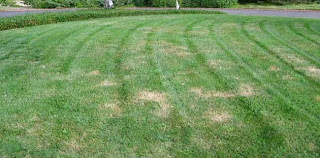Fall
is the best time of the year for lawn care, including fertilizing, weed
control, establishing a new lawn or renovating an existing lawn. The air
temperatures are generally cooler and the soil is still warm enough to
germinate the seed. Grass planted in the fall continues to build a strong root
system even after the grass blades have stopped growing.
Whether
you decide to seed or sod, start with soil preparation. Your best long-term
quality lawn depends on what you do with your soil before you seed or sod. Select
a good soil amendment such as Earth Essentials Sheep, Peat and Compost. This organic product is produced locally. A one cubic foot bag will cover about 15 square feet, one inch deep. You'll want to combine the compost with the existing soil, using ½ amendment and ½ existing soil. Rake the area, then water thoroughly. Good
soil is the key to having a healthy lawn.
When
selecting grass seed, you need to consider several factors. Is your site sunny
or shady? How much traffic will the lawn get? Do the kids and the pets play on
it? As a general rule, fescues do best in shade. Perennial ryes and bluegrass
are better for sunny and semi-shady sites. You can buy single seed or mixed (blue
grass, perennial rye and fescue) combinations.
Seed
can be purchased bulk or bagged. Buying bulk is convenient because you can purchase
the amount you need. Generally, a pound of grass seed will cover about 125
square feet.
Rake
the area to be seeded. You want the seed to come in contact with the soil. Apply
Fertilome New Lawn Starter, rake it in and water the area.
Now apply the grass
seed. For small areas, you came simply hand sow. For larger areas, use a fertilizer spreader. Next, cover the seed lightly with compost, peat moss or Straw Net and water
thoroughly.
Once the seed is wet, it must be kept moist. If the seed sprouts
and then dries out, it will die. Watering twice a day is usually sufficient,
but if it’s hot and windy, you may have to water three times a day. Perennial
rye and fescue seed will germinate in 10-12 days. Bluegrass seed can take
between 21-28 days to germinate.
These
are general guidelines for seeding your lawn. We encourage you to stop in and
discuss your specific lawn questions with us. That way, we can help you select
the right seed for your situation.


























